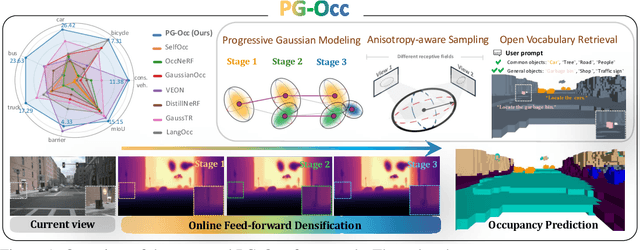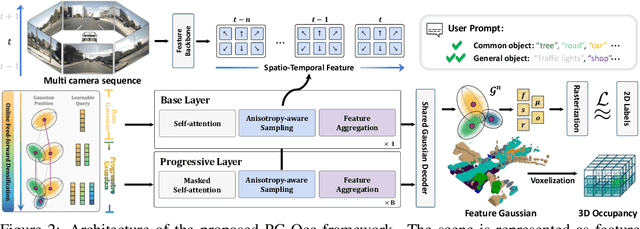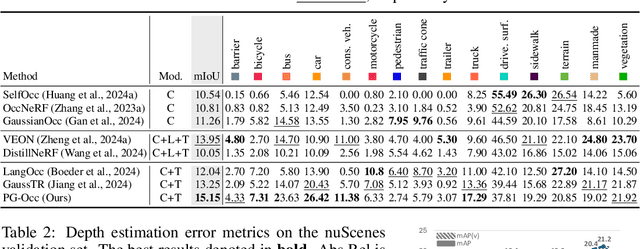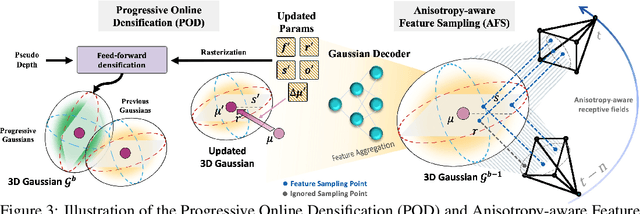Dan Xu
FullPart: Generating each 3D Part at Full Resolution
Oct 30, 2025Abstract:Part-based 3D generation holds great potential for various applications. Previous part generators that represent parts using implicit vector-set tokens often suffer from insufficient geometric details. Another line of work adopts an explicit voxel representation but shares a global voxel grid among all parts; this often causes small parts to occupy too few voxels, leading to degraded quality. In this paper, we propose FullPart, a novel framework that combines both implicit and explicit paradigms. It first derives the bounding box layout through an implicit box vector-set diffusion process, a task that implicit diffusion handles effectively since box tokens contain little geometric detail. Then, it generates detailed parts, each within its own fixed full-resolution voxel grid. Instead of sharing a global low-resolution space, each part in our method - even small ones - is generated at full resolution, enabling the synthesis of intricate details. We further introduce a center-point encoding strategy to address the misalignment issue when exchanging information between parts of different actual sizes, thereby maintaining global coherence. Moreover, to tackle the scarcity of reliable part data, we present PartVerse-XL, the largest human-annotated 3D part dataset to date with 40K objects and 320K parts. Extensive experiments demonstrate that FullPart achieves state-of-the-art results in 3D part generation. We will release all code, data, and model to benefit future research in 3D part generation.
CVD-STORM: Cross-View Video Diffusion with Spatial-Temporal Reconstruction Model for Autonomous Driving
Oct 09, 2025Abstract:Generative models have been widely applied to world modeling for environment simulation and future state prediction. With advancements in autonomous driving, there is a growing demand not only for high-fidelity video generation under various controls, but also for producing diverse and meaningful information such as depth estimation. To address this, we propose CVD-STORM, a cross-view video diffusion model utilizing a spatial-temporal reconstruction Variational Autoencoder (VAE) that generates long-term, multi-view videos with 4D reconstruction capabilities under various control inputs. Our approach first fine-tunes the VAE with an auxiliary 4D reconstruction task, enhancing its ability to encode 3D structures and temporal dynamics. Subsequently, we integrate this VAE into the video diffusion process to significantly improve generation quality. Experimental results demonstrate that our model achieves substantial improvements in both FID and FVD metrics. Additionally, the jointly-trained Gaussian Splatting Decoder effectively reconstructs dynamic scenes, providing valuable geometric information for comprehensive scene understanding.
Progressive Gaussian Transformer with Anisotropy-aware Sampling for Open Vocabulary Occupancy Prediction
Oct 06, 2025



Abstract:The 3D occupancy prediction task has witnessed remarkable progress in recent years, playing a crucial role in vision-based autonomous driving systems. While traditional methods are limited to fixed semantic categories, recent approaches have moved towards predicting text-aligned features to enable open-vocabulary text queries in real-world scenes. However, there exists a trade-off in text-aligned scene modeling: sparse Gaussian representation struggles to capture small objects in the scene, while dense representation incurs significant computational overhead. To address these limitations, we present PG-Occ, an innovative Progressive Gaussian Transformer Framework that enables open-vocabulary 3D occupancy prediction. Our framework employs progressive online densification, a feed-forward strategy that gradually enhances the 3D Gaussian representation to capture fine-grained scene details. By iteratively enhancing the representation, the framework achieves increasingly precise and detailed scene understanding. Another key contribution is the introduction of an anisotropy-aware sampling strategy with spatio-temporal fusion, which adaptively assigns receptive fields to Gaussians at different scales and stages, enabling more effective feature aggregation and richer scene information capture. Through extensive evaluations, we demonstrate that PG-Occ achieves state-of-the-art performance with a relative 14.3% mIoU improvement over the previous best performing method. Code and pretrained models will be released upon publication on our project page: https://yanchi-3dv.github.io/PG-Occ
Rep-MTL: Unleashing the Power of Representation-level Task Saliency for Multi-Task Learning
Jul 28, 2025Abstract:Despite the promise of Multi-Task Learning in leveraging complementary knowledge across tasks, existing multi-task optimization (MTO) techniques remain fixated on resolving conflicts via optimizer-centric loss scaling and gradient manipulation strategies, yet fail to deliver consistent gains. In this paper, we argue that the shared representation space, where task interactions naturally occur, offers rich information and potential for operations complementary to existing optimizers, especially for facilitating the inter-task complementarity, which is rarely explored in MTO. This intuition leads to Rep-MTL, which exploits the representation-level task saliency to quantify interactions between task-specific optimization and shared representation learning. By steering these saliencies through entropy-based penalization and sample-wise cross-task alignment, Rep-MTL aims to mitigate negative transfer by maintaining the effective training of individual tasks instead pure conflict-solving, while explicitly promoting complementary information sharing. Experiments are conducted on four challenging MTL benchmarks covering both task-shift and domain-shift scenarios. The results show that Rep-MTL, even paired with the basic equal weighting policy, achieves competitive performance gains with favorable efficiency. Beyond standard performance metrics, Power Law exponent analysis demonstrates Rep-MTL's efficacy in balancing task-specific learning and cross-task sharing. The project page is available at HERE.
UniMC: Taming Diffusion Transformer for Unified Keypoint-Guided Multi-Class Image Generation
Jul 03, 2025Abstract:Although significant advancements have been achieved in the progress of keypoint-guided Text-to-Image diffusion models, existing mainstream keypoint-guided models encounter challenges in controlling the generation of more general non-rigid objects beyond humans (e.g., animals). Moreover, it is difficult to generate multiple overlapping humans and animals based on keypoint controls solely. These challenges arise from two main aspects: the inherent limitations of existing controllable methods and the lack of suitable datasets. First, we design a DiT-based framework, named UniMC, to explore unifying controllable multi-class image generation. UniMC integrates instance- and keypoint-level conditions into compact tokens, incorporating attributes such as class, bounding box, and keypoint coordinates. This approach overcomes the limitations of previous methods that struggled to distinguish instances and classes due to their reliance on skeleton images as conditions. Second, we propose HAIG-2.9M, a large-scale, high-quality, and diverse dataset designed for keypoint-guided human and animal image generation. HAIG-2.9M includes 786K images with 2.9M instances. This dataset features extensive annotations such as keypoints, bounding boxes, and fine-grained captions for both humans and animals, along with rigorous manual inspection to ensure annotation accuracy. Extensive experiments demonstrate the high quality of HAIG-2.9M and the effectiveness of UniMC, particularly in heavy occlusions and multi-class scenarios.
HAMF: A Hybrid Attention-Mamba Framework for Joint Scene Context Understanding and Future Motion Representation Learning
May 21, 2025Abstract:Motion forecasting represents a critical challenge in autonomous driving systems, requiring accurate prediction of surrounding agents' future trajectories. While existing approaches predict future motion states with the extracted scene context feature from historical agent trajectories and road layouts, they suffer from the information degradation during the scene feature encoding. To address the limitation, we propose HAMF, a novel motion forecasting framework that learns future motion representations with the scene context encoding jointly, to coherently combine the scene understanding and future motion state prediction. We first embed the observed agent states and map information into 1D token sequences, together with the target multi-modal future motion features as a set of learnable tokens. Then we design a unified Attention-based encoder, which synergistically combines self-attention and cross-attention mechanisms to model the scene context information and aggregate future motion features jointly. Complementing the encoder, we implement the Mamba module in the decoding stage to further preserve the consistency and correlations among the learned future motion representations, to generate the accurate and diverse final trajectories. Extensive experiments on Argoverse 2 benchmark demonstrate that our hybrid Attention-Mamba model achieves state-of-the-art motion forecasting performance with the simple and lightweight architecture.
Learning Heterogeneous Mixture of Scene Experts for Large-scale Neural Radiance Fields
May 04, 2025Abstract:Recent NeRF methods on large-scale scenes have underlined the importance of scene decomposition for scalable NeRFs. Although achieving reasonable scalability, there are several critical problems remaining unexplored, i.e., learnable decomposition, modeling scene heterogeneity, and modeling efficiency. In this paper, we introduce Switch-NeRF++, a Heterogeneous Mixture of Hash Experts (HMoHE) network that addresses these challenges within a unified framework. It is a highly scalable NeRF that learns heterogeneous decomposition and heterogeneous NeRFs efficiently for large-scale scenes in an end-to-end manner. In our framework, a gating network learns to decomposes scenes and allocates 3D points to specialized NeRF experts. This gating network is co-optimized with the experts, by our proposed Sparsely Gated Mixture of Experts (MoE) NeRF framework. We incorporate a hash-based gating network and distinct heterogeneous hash experts. The hash-based gating efficiently learns the decomposition of the large-scale scene. The distinct heterogeneous hash experts consist of hash grids of different resolution ranges, enabling effective learning of the heterogeneous representation of different scene parts. These design choices make our framework an end-to-end and highly scalable NeRF solution for real-world large-scale scene modeling to achieve both quality and efficiency. We evaluate our accuracy and scalability on existing large-scale NeRF datasets and a new dataset with very large-scale scenes ($>6.5km^2$) from UrbanBIS. Extensive experiments demonstrate that our approach can be easily scaled to various large-scale scenes and achieve state-of-the-art scene rendering accuracy. Furthermore, our method exhibits significant efficiency, with an 8x acceleration in training and a 16x acceleration in rendering compared to Switch-NeRF. Codes will be released in https://github.com/MiZhenxing/Switch-NeRF.
Audio-visual Controlled Video Diffusion with Masked Selective State Spaces Modeling for Natural Talking Head Generation
Apr 03, 2025Abstract:Talking head synthesis is vital for virtual avatars and human-computer interaction. However, most existing methods are typically limited to accepting control from a single primary modality, restricting their practical utility. To this end, we introduce \textbf{ACTalker}, an end-to-end video diffusion framework that supports both multi-signals control and single-signal control for talking head video generation. For multiple control, we design a parallel mamba structure with multiple branches, each utilizing a separate driving signal to control specific facial regions. A gate mechanism is applied across all branches, providing flexible control over video generation. To ensure natural coordination of the controlled video both temporally and spatially, we employ the mamba structure, which enables driving signals to manipulate feature tokens across both dimensions in each branch. Additionally, we introduce a mask-drop strategy that allows each driving signal to independently control its corresponding facial region within the mamba structure, preventing control conflicts. Experimental results demonstrate that our method produces natural-looking facial videos driven by diverse signals and that the mamba layer seamlessly integrates multiple driving modalities without conflict.
Flow-NeRF: Joint Learning of Geometry, Poses, and Dense Flow within Unified Neural Representations
Mar 13, 2025



Abstract:Learning accurate scene reconstruction without pose priors in neural radiance fields is challenging due to inherent geometric ambiguity. Recent development either relies on correspondence priors for regularization or uses off-the-shelf flow estimators to derive analytical poses. However, the potential for jointly learning scene geometry, camera poses, and dense flow within a unified neural representation remains largely unexplored. In this paper, we present Flow-NeRF, a unified framework that simultaneously optimizes scene geometry, camera poses, and dense optical flow all on-the-fly. To enable the learning of dense flow within the neural radiance field, we design and build a bijective mapping for flow estimation, conditioned on pose. To make the scene reconstruction benefit from the flow estimation, we develop an effective feature enhancement mechanism to pass canonical space features to world space representations, significantly enhancing scene geometry. We validate our model across four important tasks, i.e., novel view synthesis, depth estimation, camera pose prediction, and dense optical flow estimation, using several datasets. Our approach surpasses previous methods in almost all metrics for novel-view view synthesis and depth estimation and yields both qualitatively sound and quantitatively accurate novel-view flow. Our project page is https://zhengxunzhi.github.io/flownerf/.
GaussHDR: High Dynamic Range Gaussian Splatting via Learning Unified 3D and 2D Local Tone Mapping
Mar 13, 2025



Abstract:High dynamic range (HDR) novel view synthesis (NVS) aims to reconstruct HDR scenes by leveraging multi-view low dynamic range (LDR) images captured at different exposure levels. Current training paradigms with 3D tone mapping often result in unstable HDR reconstruction, while training with 2D tone mapping reduces the model's capacity to fit LDR images. Additionally, the global tone mapper used in existing methods can impede the learning of both HDR and LDR representations. To address these challenges, we present GaussHDR, which unifies 3D and 2D local tone mapping through 3D Gaussian splatting. Specifically, we design a residual local tone mapper for both 3D and 2D tone mapping that accepts an additional context feature as input. We then propose combining the dual LDR rendering results from both 3D and 2D local tone mapping at the loss level. Finally, recognizing that different scenes may exhibit varying balances between the dual results, we introduce uncertainty learning and use the uncertainties for adaptive modulation. Extensive experiments demonstrate that GaussHDR significantly outperforms state-of-the-art methods in both synthetic and real-world scenarios.
 Add to Chrome
Add to Chrome Add to Firefox
Add to Firefox Add to Edge
Add to Edge